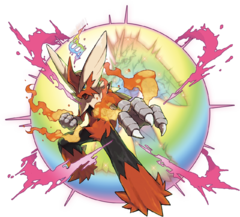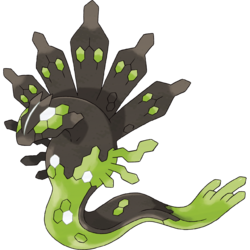Welcome Back, Trainer
Part 5: From A to Y
The sixth generation of Pokemon was a big deal for a lot of reasons. I’m going to expound on many of them over the course of this article; but before I get into the nuts and bolts, I want to go all wishy-washy, touchy-feely on you and discuss why I love Pokemon X and Pokemon Y.
It starts with Pokemon Stadium. For those that might not remember, Stadium was a game for the Nintendo 64 that was released during the first wave of Pokemon hype. While it was a passable standalone game, the major selling point was the ability to import the pokemon you had trained on your handheld system. With your team loaded into Stadium, you could command them in battle on your television screen – rendered in gorgeous, three-dimensional polygons and pixels.
If you Google screen caps of Pokemon Stadium gameplay, you will probably raise a skeptical eyebrow over my use of the word “gorgeous”. But when I was ten, I had only known my pokemon as blots of barely decipherable pixels. Seeing them as fully animated creatures was a whole new level of wonder.
That kernel of wonder still sits in my heart. No matter what their flaws, I cannot dislike X and Y. The sixth generation headliners brought the experience of Stadium to the handheld systems – a development I had been waiting 18 years for:
3D Graphics
And they really were gorgeous. The animations of X and Y were everything ten-year-old me wanted when he jammed his Game Boy screen to his eyes, trying to discern what Geodude actually looked like. Since generation six, Pokemon’s aesthetics have only improved – but more on that next time. For now, let’s stop talking about form and get into function.
X and Y
Pokemon X and Pokemon Y had a substantial technological upgrade to work with, and so they added a lot of bells and whistles – a lot of flash and bang. Most of their new features were cool little details that made the setting of Kalos feel more like the adaptation of France that it was. But when long-time fans talk about the sixth generation, there is always one topic that rears its ugly head – and it’s one that has always been a problem for Pokemon: difficulty.
I need to introduce you to the EXP Share. The EXP Share is an item that has been with Pokemon since the first generation. Its purpose is to help the strength of your party members remain even so that your team is balanced and well-rounded.
In the first generation, it was a key item that you could toggle on and off. When it was on, all pokemon in your party received experience at the end of a battle. Like most things in the first generation, the item was not properly balanced, and so it seemed more detrimental than beneficial.
From generations 2-5, the EXP Share became a hold item that could be given to one of your pokemon. While holding it, any battle experience would be shared between active combatants and the pokemon with the EXP Share.
In the sixth generation, the toggler approach was reintroduced – and freshly balanced! So that the item didn’t feel like a waste of time to use! Only, it really wasn’t. In Pokemon X and Pokemon Y, the EXP Share took what was supposed to be a moderately challenging game and made it into a cake walk. By making the EXP payout more generously divvied up, it ensured that your team’s growth was exponentially faster. The result was that you were consistently many levels above everything around you and had little trouble smacking opponents around.
The EXP Share hung a lampshade on an issue that has always been a touchy subject for the fandom: the challenge of the games. Pokemon players typically divide into two camps: kids discovering Pokemon and adults returning to Pokemon. While both of these camps will spend money on the games, one of them is much more likely to be scared off by a traumatizing party-wipe. As a result, the developers tend to skew their mechanic design in favour of the youthful explorers, rather than the grizzled veterans.
If they have to choose between increasing the challenge to make the veterans happy, or decreasing it to make the games more accessible, the designers will choose accessibility every time.
The toggle-style EXP Share was carried over into the seventh generation, but what effect it had there is a subject for another time. Let’s instead talk about what the sixth generation added to the franchise:
72 New Pokemon
The appearance of new pokemon should be old hat to you by this point; every generation needs some trademark critters to set it apart from what came before. The big difference between the sixth generation and the others was how few new creatures were unveiled. Every other new generation debuted at least 100 pokemon, the sixth slowed this pace substantially.
The number of pokemon species is quickly approaching 1000. Most fans agree that this number will be a hard one for pokemon to deal with. Balancing the games would become a nightmare with that many variables. It makes sense that as the dread threshold approaches, the designers would slow production in order to streamline gameplay.
However, the staggering number of pokemon didn’t stop the developers from making a change that hadn’t been seen for three generations. In X and Y, Pokemon added a new type:
Fairy Type
Fairy pokemon – like Dark and Steel pokemon before them – were introduced for the sake of game balance. Over the years, it had become obvious that there were some clear winners and losers when it came to pokemon types.
The competitive scene was dominated by Dragon-types. Dark and Fighting-type attacks were too strong, while Poison and Steel-type attacks hit only a handful of pokemon for decent damage. Fairy helped remedy these issues. I’ll break it down for you:
- Fairy helped shake the dominance of Dragons. Fairies are immune to Dragon-type attacks and hit Dragon-types for super effective damage.
- Fairy allowed more pokemon to switch into powerful hits. Both Dark-type and Fighting-type moves have great “neutral coverage”. This means that while they don’t hit a ton of things for super effective damage, there are very few pokemon that actively resist them. Fairy resists both types.
- Fairy helped make struggling pokemon viable. Fairy’s two weakness – Steel and Poison – were both types that lacked offensive presence. By giving these two types new prey – prey that, in turn, preyed on the apex predators of the time – made sure that some pokemon relegated to the sidelines could have their moment in the sun.
- As an extension of the previous point, one often-overlooked feature of the Fairy-type is its interaction with the Fire-type. Fire has always been a powerful offensive type, while lacking on the defence. Fire’s list of weaknesses reads like a whose-who of common competitive attacks. Making a new common attacking type that is resisted by Fire-types helps those fiery favourites make it into battle safely.
While there were many new Fairy-type pokemon introduced, the type was also retroactively applied to many older species of pokemon. This has helped many older ‘mons get a new lease on life. But those receiving a new typing weren’t the only ones helped by generation six:
Enhanced Stats on Old Pokemon
As time has passed, the power of pokemon has increased. Each new generation has to push the envelope of what its monsters can do in order for that generation to matter. What this means is that in each generation, some new pokemon will make old pokemon obsolete. Of course, this progress can go too far, creating a stale battling environment in which the new hotness is the only option. Going into the sixth generation, new-stuff stasis was a looming threat.
To combat the creeping power level of new pokemon, the developers decided that some pokemon from yesteryear needed a leg-up. Pokemon like Butterfree and Pidgeot saw their base stats increase when they were brought into X and Y. For some old favourites, things were taken a step further, and they were incorporated into the marquee mechanic of the sixth generation:
Mega Evolution
Eventually, there comes a point when subtlety is not enough. When making incremental changes doesn’t capture attention. Sometimes, when you want everyone to look at you, you have to make a lot of noise and throw things. Mega Evolution is Pokemon standing on a soapbox in a crowded courtyard and calling doom onto the passersby.
In brief: Mega Evolution is accomplished through the use of a Mega Stone – this is a hold item that corresponds to a specific pokemon species meant to hold it. When that species is holding its stone, it can Mega Evolve. Mega Evolution can change a pokemon’s typing, its ability, and its stats. Generally speaking, these changes translate into strict upgrades. The upgrade only lasts for the duration of a single battle and it can only be used once per battle.
Mega Evolution is loud, flashy, and very cool. The designs for the mega evolved pokemon tend to be imposing and impressive, and using them in battle feels extremely empowering. Of course, all that power comes at a cost. In this case, the cost is centralization. In any battle environment in which they are allowed, mega evolutions dominate. They become both the crux of your team and the thing that worries you most on your opponent’s side.
The fans reaction to Mega Evolution was as two-sided as the mechanic itself. Many people loved that long-neglected pokemon – like Ampharos – were being given the chance to come into their own, while others lamented that more often than not, you either played with a mega evolution – or you lost the battle. Since Mega Evolution has stuck around, the debate still rages on today.
Less controversial, was our next change:
Trainer Customization
One of the most warmly-received features in the history of Pokemon was the ability to play around with the default options for skin-tone, eye colour, and clothing. Starting with the sixth generation, trainers could purchase new clothing options throughout their adventure, allowing them to have a character whose appearance progresses with their abilities as a trainer.
It’s no secret that the Pokemon games are a glorified self-insertion fantasy, and allowing the players to make their avatars a little more personally meaningful was a savvy touch on the part of the designers.
While the games helped you relate to your character in a much deeper way, they also let you find a new bond with your pokemon:
Pokemon Petting
Yes, that is an awkward title for this section.
No, I couldn’t think of a more comfortable way of putting it.
The feature – known as Pokemon Amie in the sixth generation – was a mini-game in which you used the 3DS’s touch screen to groom, pet, and feed your pokemon. By doing this, you increased your bond with that pokemon, and it would pay dividends. These rewards would include things like the pokemon withstanding an attack that would otherwise knock it out, dodging a normally accurate attack from a foe, or scoring a critical hit thanks to nothing but their willpower.
While the tangible rewards for using Amie were an incentive, it seems like the feature was a smash hit and kept in the games for a much simpler reason. The fans seemed to love the personality that the up-close interaction imbued their pokemon with. They felt far more connected with their Eevee when they could see its joy at having its ears scratched.
Z?
Ever since Emerald, the expectation of the sequel has been in the hearts of Pokemon fans. X and Y did not seem like they were going to disappoint. Hidden in a cave within the games was a legendary pokemon – one that seemed out-of-place – not quite as powerful as the two mascots; as if it were waiting for its own moment in the spotlight. Hell, it was even shaped like a ‘Z’.
But Zygarde’s moment never came.
There is a lot of speculation as to why Pokemon Z never materialized, but nothing has ever been confirmed or denied through official channels. But, unlike generation five, while there was no sequel, the remakes were back in full-force.
Alpha Sapphire/Omega Ruby
Oh man. To say I was excited about my favourite generation of Pokemon getting launched into the world of 3D would be an understatement. When it was confirmed that Ruby and Sapphire would be getting an update, I immediately started planning what my new adventure through Hoenn would be like.
Omega Ruby and Alpha Sapphire are excellent Pokemon games. They incorporate all of the new mechanics, tweaking a few to make them their own, and present the gorgeous Hoenn region with the splendour you would expect.
But while they are the experience I had hoped for, they did not do much to make a lasting imprint on the franchise. ORAS represents the culmination of Pokemon’s old epoch. They are the denouement of the franchise’s first nineteen years, and they remain a worthwhile endeavour.
Smell Yah Later
Thanks for sticking with me Pokemon fans. If you have been keeping up, you have a pretty good idea of what to expect when you are booting up your copy of Pokemon Sun or Pokemon Moon. I hope you are as excited as I was to play this latest generation of Pokemon.
I will be taking a week off next week, but I will return in the second week of January with a full, in-depth review of Pokemon Sun and Moon. I hope to see you all then!
When Jackson ventures out of the tall grass, he in a content writer for AYBOnline. His opinions are his own.








